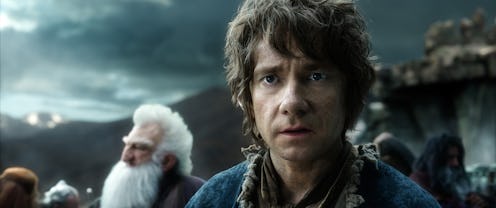Entertainment
How Does the Third 'Hobbit' Lead Into 'LOTR'?

One of the driving forces that got us through the lackluster Star Wars Prequel Trilogy was finding out how the mild-mannered, theatrically deficient tween known as Anakin Skywalker became the vicious, megalomaniacal, asthmatic Darth Vader. Peter Jackson’s second string of Middle-earth movies don’t quite have the same air of mystery to thrive on: anyone who wants to know how the story of Bilbo Baggins begets that of Frodo and his Fellowship can dive into the writings of J.R.R. Tolkien to find any and all necessary information. But for those without the time or resources to rifle through Tolkien’s Legendarium, we can help you out.
The Hobbit: The Battle of the Five Armies takes a few concerted efforts to tie its trilogy’s story in with that of the far more complex (and qualitatively superior) Lord of the Rings storyline. Even to newbies, there should be a few obvious connections: Characters like Biblo Baggins (played in The Hobbit films by Martin Freeman and in The Lord of the Rings by Ian Holm), Gandalf the Grey (Ian McKellen), Legolas (Orlando Bloom), Galadriel (Cate Blanchett), Elrond (Hugo Weaving), Saruman (Christopher Lee), and Gollum (Andy Serkis) take stead in both trilogies, to varying degrees. Bilbo’s collection of the ring in An Unexpected Journey and possession thereof throughout The Desolation of Smaug and Five Armies allows for its passage to Frodo in The Fellowship of the Ring, setting off the very premise of the trilogy in question.
But more specific links materialize in the second half of Battle of the Five Armies. Three, in particular (and be warned—major spoilers follow!):
The first involves that ever-present nuisance Sauron. As we learn in the introduction to The Fellowship of the Ring, Sauron (after forging all the rings, distributing them to the races of Elf, Dwarf, and Man, and aiming to enslave the lot via the powers of his own ring — the “one ring to rule them all” — he is defeated on the battlefield by Isildur, a Man King. But since death is largely a fickle condition in Middle-earth, Sauron simply takes the ghastly shadow form of the Necromancer that we see him bear in the Hobbit movies.
Having captured Gandalf and Radagast the Brown by the end of Desolation, Sauron attracts Galadriel, Saruman, and Elrond (hoping to rescue the wizards) to his realm, attacking the group upon arrival. The fight concludes with Galadriel effectively laying waste to his anthropomorphic stature, banishing him “back from whence he came” (and relegating the character to the more familiar eye form introduced in the Lord of the Rings movies).
Once again, this is really only a temporary setback, as he isn’t exactly done causing trouble once Fellowship rolls around. And speaking of which…
Although we meet a few members of the Fellowship in the Hobbit trilogy, we’re kept guessing as to how they ultimately find themselves on such a quest, those many years later. We do get a few hints when it comes to Legolas, who parts ways with his Elvish brethren at the end of Five Armies after recognizing that he’ll never have the heart of his beloved Tauriel, who is, at this point, left pining for a dead Dwarf she met something in the neighborhood of three weeks prior.
Feeling as though he has no place left among his family, Legolas insists to his father and ruler that he take leave, earning the latter’s blessing and guidance: go find the Man called Strider, otherwise known as Aragorn — Ranger of the North and a future member of the Fellowship.
Though we close Five Armies with many years separating Bilbo’s adventures from those of Frodo, we find young Martin Freeman give way to Ian Holm, sitting silently in his hole, clutching desperately at that all-consuming ring when Gandalf comes knocking. A tragic sendoff to a humble, good-natured hero… but one we needed, you must suppose, in order to get the majesty that is The Lord of the Rings.
Images: New Line Cinema (3)